How Are Feedbacks Represented in Land Models?
Abstract
:1. Introduction
2. Materials and Methods
2.1. Feedback in the Conceptual Model and Computational Model
2.2. Literature Search
2.3. Indicators Used
3. Results
3.1. Feedback Processes between Land Use Systems and Related Systems
3.2. Representation of Feedback in the Models
3.3. Reported Effects of Feedback
4. Discussion
4.1. What Drives the Modelling of Feedbacks that Involve Land System Processes?
4.2. How Are Land Changes Represented?
4.3. How Are the Effects of Feedbacks Explored?
5. Conclusions
Supplementary Materials
Acknowledgments
Author Contributions
Conflicts of Interest
References
- Foley, J.A.; DeFries, R.; Asner, G.P.; Barford, C.; Bonan, G.; Carpenter, S.R.; Chapin, F.S.; Coe, M.T.; Daily, G.C.; Gibbs, H.K. Global consequences of land use. Science 2005, 309, 570–574. [Google Scholar] [CrossRef] [PubMed]
- Kalnay, E.; Cai, M. Impact of urbanization and land-use change on climate. Nature 2003, 423, 528–531. [Google Scholar] [CrossRef] [PubMed]
- Matson, P.A.; Parton, W.J.; Power, A.G.; Swift, M.J. Agricultural intensification and ecosystem properties. Science 1997, 277, 504–509. [Google Scholar] [CrossRef] [PubMed]
- Tilman, D.; Fargione, J.; Wolff, B.; D’Antonio, C.; Dobson, A.; Howarth, R.; Schindler, D.; Schlesinger, W.H.; Simberloff, D.; Swackhamer, D. Forecasting agriculturally driven global environmental change. Science 2001, 292, 281–284. [Google Scholar] [CrossRef] [PubMed]
- GLP. Global Land Project “Science Plan and Implementation Strategy”; GLP: Stockholm, Sweden, 2005; pp. 3–9. [Google Scholar]
- Aström, K.J.; Murray, R.M. Feedback Systems: An Introduction for Scientists and Engineers; Princeton University Press: Princeton, NJ, USA, 2008; p. 1. [Google Scholar]
- Garrett, R.D.; Lambin, E.F.; Naylor, R.L. The new economic geography of land use change: Supply chain configurations and land use in the brazilian amazon. Land Use Policy 2013, 34, 265–275. [Google Scholar] [CrossRef]
- Lambin, E.F.; Meyfroidt, P. Global land use change, economic globalization, and the looming land scarcity. Proc. Natl. Acad. Sci. USA 2011, 108, 3465–3472. [Google Scholar] [CrossRef] [PubMed]
- Liu, J.; Dietz, T.; Carpenter, S.R.; Alberti, M.; Folke, C.; Moran, E.; Pell, A.N.; Deadman, P.; Kratz, T.; Lubchenco, J.; et al. Complexity of coupled human and natural systems. Science 2007, 317, 1513–1516. [Google Scholar] [CrossRef] [PubMed]
- Agarwal, C.; Green, G.M.; Grove, J.M.; Evans, T.P.; Schweik, C.M. A Review and Assessment of Land-Use Change Models: Dynamics of Space, Time, and Human Choice; Center for the Study of Institutions, Population, and Environmental Change, Indiana University: Bloomington, IN, USA, 2002. [Google Scholar]
- Parker, D.C.; Hessl, A.; Davis, S.C. Complexity, land-use modeling, and the human dimension: Fundamental challenges for mapping unknown outcome spaces. Geoforum 2008, 39, 789–804. [Google Scholar] [CrossRef]
- Le, Q.B.; Seidl, R.; Scholz, R.W. Feedback loops and types of adaptation in the modelling of land-use decisions in an agent-based simulation. Environ. Model. Softw. 2012, 27, 83–96. [Google Scholar] [CrossRef]
- Turner, B.L.; Lambin, E.F.; Reenberg, A. The emergence of land change science for global environmental change and sustainability. Proc. Natl. Acad. Sci. USA 2007, 104, 20666–20671. [Google Scholar] [CrossRef] [PubMed]
- Lambin, E.F.; Meyfroidt, P. Land use transitions: Socio-ecological feedback versus socio-economic change. Land Use Policy 2010, 27, 108–118. [Google Scholar] [CrossRef]
- Rietkerk, M.; Dekker, S.C.; de Ruiter, P.C.; van de Koppel, J. Self-organized patchiness and catastrophic shifts in ecosystems. Science 2004, 305, 1926–1929. [Google Scholar] [CrossRef] [PubMed]
- Rounsevell, M.D.A.; Pedroli, B.; Erb, K.-H.; Gramberger, M.; Busck, A.G.; Haberl, H.; Kristensen, S.; Kuemmerle, T.; Lavorel, S.; Lindner, M.; et al. Challenges for land system science. Land Use Policy 2012, 29, 899–910. [Google Scholar] [CrossRef]
- Forrester, J.W. Lessons from system dynamics modeling. Syst. Dyn. Rev. 1987, 3, 136–149. [Google Scholar] [CrossRef]
- Gutierrez, L.T.; Fey, W.R. Ecosystem Succession. A General Hypothesis and a Test Model of a Grassland; MIT Press: Cambridge, MA, USA, 1980. [Google Scholar]
- Zeigler, B.P. Multifacetted Modelling and Discrete Event Simulation; Academic Press Professional, Inc.: London, UK, 1984. [Google Scholar]
- Kelly, R.A.; Jakeman, A.J.; Barreteau, O.; Borsuk, M.E.; ElSawah, S.; Hamilton, S.H.; Henriksen, H.J.; Kuikka, S.; Maier, H.R.; Rizzoli, A.E.; et al. Selecting among five common modelling approaches for integrated environmental assessment and management. Environ. Model. Softw. 2013, 47, 159–181. [Google Scholar] [CrossRef]
- Neuwirth, C.; Peck, A.; Simonović, S.P. Modeling structural change in spatial system dynamics: A daisyworld example. Environ. Model. Softw. 2015, 65, 30–40. [Google Scholar] [CrossRef] [PubMed]
- Perestrello de Vasconcelos, M.J.; Zeigler, B.P. Discrete-event simulation of forest landscape response to fire disturbances. Ecol. Model. 1993, 65, 177–198. [Google Scholar] [CrossRef]
- Verburg, P.H. Simulating feedbacks in land use and land cover change models. Landsc. Ecol. 2006, 21, 1171–1183. [Google Scholar] [CrossRef]
- Rotmans, J. Image: An Integrated Model to Assess the Greenhouse Effect; Kluwer: Dordrecht, The Netherlands, 1990. [Google Scholar]
- Claessens, L.; Schoorl, J.M.; Verburg, P.H.; Geraedts, L.; Veldkamp, A. Modelling interactions and feedback mechanisms between land use change and landscape processes. Agric. Ecosyst. Environ. 2009, 129, 157–170. [Google Scholar] [CrossRef]
- Deadman, P.; Robinson, D.; Moran, E.; Brondizio, E. Colonist household decisionmaking and land-use change in the amazon rainforest: An agent-based simulation. Environ. Plan. B-Plan. Des. 2004, 31, 693–709. [Google Scholar] [CrossRef]
- Priess, J.A.; De Koning, G.H.J.; Veldkamp, A. Assessment of interactions between land use change and carbon and nutrient fluxes in ecuador. Agric. Ecosyst. Environ. 2001, 85, 269–279. [Google Scholar] [CrossRef]
- Oliveira, L.J.C.; Costa, M.H.; Soares-Filho, B.S.; Coe, M.T. Large-scale expansion of agriculture in amazonia may be a no-win scenario. Environ. Res. Lett. 2013, 8, 024021:1–024021:10. [Google Scholar] [CrossRef]
- Olson, J.M.; Alagarswamy, G.; Andresen, J.A.; Campbell, D.J.; Davis, A.Y.; Ge, J.; Huebner, M.; Lofgren, B.M.; Lusch, D.P.; Moore, N.J.; et al. Integrating diverse methods to understand climate–land interactions in East Africa. Geoforum 2008, 39, 898–911. [Google Scholar] [CrossRef]
- Strengers, B.J.; Müller, C.; Schaeffer, M.; Haarsma, R.J.; Severijns, C.; Gerten, D.; Schaphoff, S.; Van Den Houdt, R.; Oostenrijk, R. Assessing 20th century climate-vegetation feedbacks of land-use change and natural vegetation dynamics in a fully coupled vegetation-climate model. Int. J. Climatol. 2010, 30, 2055–2065. [Google Scholar] [CrossRef]
- Filatova, T.; Verburg, P.H.; Parker, D.C.; Stannard, C.A. Spatial agent-based models for socio-ecological systems: Challenges and prospects. Environ. Model. Softw. 2013, 45, 1–7. [Google Scholar] [CrossRef]
- Parker, D.C.; Manson, S.M.; Janssen, M.A.; Hoffmann, M.J.; Deadman, P. Multi-agent systems for the simulation of land-use and land-cover change: A review. Ann. Assoc. Am. Geogr. 2003, 93, 314–337. [Google Scholar] [CrossRef]
- Bousquet, F.; Le Page, C. Multi-agent simulations and ecosystem management: A review. Ecol. Model. 2004, 176, 313–332. [Google Scholar] [CrossRef]
- Hare, M.; Deadman, P. Further towards a taxonomy of agent-based simulation models in environmental management. Math. Comput. Simul. 2004, 64, 25–40. [Google Scholar] [CrossRef]
- Heistermann, M.; Müller, C.; Ronneberger, K. Land in sight? Achievements, deficits and potentials of continental to global scale land-use modeling. Agric. Ecosyst. Environ. 2006, 114, 141–158. [Google Scholar] [CrossRef]
- Matthews, R.B.; Gilbert, N.G.; Roach, A.; Polhill, J.G.; Gotts, N.M. Agent-based land-use models: A review of applications. Landsc. Ecol. 2007, 22, 1447–1459. [Google Scholar] [CrossRef]
- Schaldach, R.; Priess, J.A. Integrated models of the land system: A review of modelling approaches on the regional to global scale. Living Rev. Landsc. Res. 2008, 2, 1–34. [Google Scholar] [CrossRef]
- Luus, K.A.; Robinson, D.T.; Deadman, P.J. Representing ecological processes in agent-based models of land use and cover change. J. Land Use Sci. 2013, 8, 175–198. [Google Scholar] [CrossRef]
- Schlüter, M.; McAllister, R.; Arlinghaus, R.; Bunnefeld, N.; Eisenack, K.; Hoelker, F.; Milner-Gulland, E.; Müller, B.; Nicholson, E.; Quaas, M. New horizons for managing the environment: A review of coupled social-ecological systems modeling. Nat. Resour. Model. 2012, 25, 219–272. [Google Scholar] [CrossRef]
- An, L. Modeling human decisions in coupled human and natural systems: Review of agent-based models. Ecol. Model. 2012, 229, 25–36. [Google Scholar] [CrossRef]
- Meyfroidt, P. Environmental cognitions, land change, and social–ecological feedbacks: An overview. J. Land Use Sci. 2013, 8, 341–367. [Google Scholar] [CrossRef]
- Michetti, M.; Zampieri, M. Climate–human–land interactions: A review of major modelling approaches. Land 2014, 3, 793–833. [Google Scholar] [CrossRef]
- Rounsevell, M.D.A.; Arneth, A.; Alexander, P.; Brown, D.G.; de Noblet-Ducoudre, N.; Ellis, E.; Finnigan, J.; Galvin, K.; Grigg, N.; Harman, I.; et al. Towards decision-based global land use models for improved understanding of the earth system. Earth Syst. Dyn. 2014, 5, 117–137. [Google Scholar] [CrossRef]
- Filatova, T.; Polhill, J.G.; van Ewijk, S. Regime shifts in coupled socio-environmental systems: Review of modelling challenges and approaches. Environ. Model. Softw. 2016, 75, 333–347. [Google Scholar] [CrossRef]
- Putman, S.H. Preliminary results from an integrated transportation and land use models package. Transportation 1974, 3, 193–224. [Google Scholar] [CrossRef]
- Jones, D.W.; O’Neill, R.V. Land use with endogenous environmental degradation and conservation. Resour. Energy 1992, 14, 381–400. [Google Scholar] [CrossRef]
- Leemans, R. Determining the global significance of local and regional mitigation strategies: Setting the scene with global integrated assessment models. Environ. Monit. Assess. 1995, 38, 205–216. [Google Scholar] [CrossRef] [PubMed]
- Levinson, D.M. Evolutionary transportation planning model: Structure and application. Transp. Res. Rec. 1995, 1493, 64–73. [Google Scholar]
- Veldkamp, A.; Fresco, L.O. Clue-cr: An integrated multi-scale model to simulate land use change scenarios in costa rica. Ecol. Model. 1996, 91, 231–248. [Google Scholar] [CrossRef]
- Rousseau, G.; Clymer, T. Travel demand modeling and conformity determination: Atlanta regional commission case study. Transp. Res. Rec. 2002, 1817, 172–176. [Google Scholar] [CrossRef]
- Soares-Filho, B.S.; Coutinho Cerqueira, G.; Lopes Pennachin, C. Dinamica—A stochastic cellular automata model designed to simulate the landscape dynamics in an amazonian colonization frontier. Ecol. Model. 2002, 154, 217–235. [Google Scholar] [CrossRef]
- Parker, D.C.; Meretsky, V. Measuring pattern outcomes in an agent-based model of edge-effect externalities using spatial metrics. Agric. Ecosyst. Environ. 2004, 101, 233–250. [Google Scholar] [CrossRef]
- Gupta, S.; Kalmanje, S.; Kockelman, K.M. Road pricing simulations: Traffic, land use and welfare impacts for Austin, Texas. Transp. Plan. Technol. 2006, 29, 1–23. [Google Scholar] [CrossRef]
- Waddell, P.; Ulfarsson, G.F.; Franklin, J.P.; Lobb, J. Incorporating land use in metropolitan transportation planning. Transp. Res. A: Policy Pract. 2007, 41, 382–410. [Google Scholar] [CrossRef]
- Wu, W.; Shibasaki, R.; Yang, P.; Tan, G.; Matsumura, K.I.; Sugimoto, K. Global-scale modelling of future changes in sown areas of major crops. Ecol. Model. 2007, 208, 378–390. [Google Scholar] [CrossRef]
- Koch, J.; Schaldach, R.; Köchy, M. Modeling the impacts of grazing land management on land-use change for the jordan river region. Glob. Planet. Chang. 2008, 64, 177–187. [Google Scholar] [CrossRef]
- Moreira, E.; Costa, S.; Aguiar, A.P.; Câmara, G.; Carneiro, T. Dynamical coupling of multiscale land change models. Landsc. Ecol. 2009, 24, 1183–1194. [Google Scholar] [CrossRef]
- Xu, X.; Gao, Q.; Liu, Y.H.; Wang, J.A.; Zhang, Y. Coupling a land use model and an ecosystem model for a crop-pasture zone. Ecol. Model. 2009, 220, 2503–2511. [Google Scholar] [CrossRef]
- Duthie, J.; Voruganti, A.; Kockelman, K.; Waller, S.T. Highway improvement project rankings due to uncertain model inputs: Application of traditional transportation and land use models. J. Urban Plan. Dev. 2010, 136, 294–302. [Google Scholar] [CrossRef]
- Devaraju, N.; Cao, L.; Bala, G.; Caldeira, K.; Nemani, R. A model investigation of vegetation-atmosphere interactions on a millennial timescale. Biogeosciences 2011, 8, 3677–3686. [Google Scholar] [CrossRef]
- Kitchen, M.; Outwater, M.L.; Johnson, C.; Simonson, M.H.; Caballero, P.; Coe, S. Testing the puget sound’s land use model response to transportation strategies. Transp. Lett. 2011, 3, 135–148. [Google Scholar] [CrossRef]
- Priess, J.A.; Schweitzer, C.; Wimmer, F.; Batkhishig, O.; Mimler, M. The consequences of land-use change and water demands in central mongolia. Land Use Policy 2011, 28, 4–10. [Google Scholar] [CrossRef]
- Tóth, S.F.; Haight, R.G.; Rogers, L.W. Dynamic reserve selection: Optimal land retention with land-price feedbacks. Oper. Res. 2011, 59, 1059–1078. [Google Scholar] [CrossRef]
- Martin, G.M.; Levine, R.C. The influence of dynamic vegetation on the present-day simulation and future projections of the south asian summer monsoon in the hadgem2 family. Earth Syst. Dyn. 2012, 3, 245–261. [Google Scholar] [CrossRef]
- Güneralp, B.; Reilly, M.K.; Seto, K.C. Capturing multiscalar feedbacks in urban land change: A coupled system dynamics spatial logistic approach. Environ. Plan. B: Plan. Des. 2012, 39, 858–879. [Google Scholar] [CrossRef]
- Pendyala, R.; Konduri, K.; Chiu, Y.C.; Hickman, M.; Noh, H.; Waddell, P.; Wang, L.; You, D.; Gardner, B. Integrated land use-transport model system with dynamic time-dependent activity-travel microsimulation. Transp. Res. Rec. 2012. [Google Scholar] [CrossRef]
- BenDor, T.; Westervelt, J.; Song, Y.; Sexton, J.O. Modeling park development through regional land use change simulation. Land Use Policy 2013, 30, 1–12. [Google Scholar] [CrossRef]
- Jones, A.D.; Collins, W.D.; Edmonds, J.; Torn, M.S.; Janetos, A.; Calvin, K.V.; Thomson, A.; Chini, L.P.; Mao, J.; Shi, X.; et al. Greenhouse gas policy influences climate via direct effects of land-use change. J. Clim. 2013, 26, 3657–3670. [Google Scholar] [CrossRef]
- Murray-Rust, D.; Rieser, V.; Robinson, D.T.; Miličič, V.; Rounsevell, M. Agent-based modelling of land use dynamics and residential quality of life for future scenarios. Environ. Model. Softw. 2013, 46, 75–89. [Google Scholar] [CrossRef]
- Robinson, D.T.; Sun, S.; Hutchins, M.; Riolo, R.L.; Brown, D.G.; Parker, D.C.; Filatova, T.; Currie, W.S.; Kiger, S. Effects of land markets and land management on ecosystem function: A framework for modelling exurban land-change. Environ. Model. Softw. 2013, 45, 129–140. [Google Scholar] [CrossRef]
- Zhang, Y.; Sun, Y.; Chen, Z. Simulation of land use change using multi-agent model. Nongye Gongcheng Xuebao/Trans. Chin. Soc. Agric. Eng. 2013, 29, 255–265. [Google Scholar]
- Pongratz, J.; Reick, C.H.; Houghton, R.A.; House, J.I. Terminology as a key uncertainty in net land use and land cover change carbon flux estimates. Earth Syst. Dyn. 2014, 5, 177–195. [Google Scholar] [CrossRef]
- Su, H.; Wu, J.H.; Tan, Y.; Bao, Y.; Song, B.; He, X. A land use and transportation integration method for land use allocation and transportation strategies in china. Transp. Res. A: Policy Pract. 2014, 69, 329–353. [Google Scholar] [CrossRef]
- Connor, J.D.; Bryan, B.A.; Nolan, M.; Stock, F.; Gao, L.; Dunstall, S.; Graham, P.; Ernst, A.; Newth, D.; Grundy, M.; et al. Modelling australian land use competition and ecosystem services with food price feedbacks at high spatial resolution. Environ. Model. Softw. 2015, 69, 141–154. [Google Scholar] [CrossRef]
- Guillem, E.E.; Murray-Rust, D.; Robinson, D.T.; Barnes, A.; Rounsevell, M.D.A. Modelling farmer decision-making to anticipate tradeoffs between provisioning ecosystem services and biodiversity. Agric. Syst. 2015, 137, 12–23. [Google Scholar] [CrossRef]
- Tsai, Y.; Zia, A.; Koliba, C.; Bucini, G.; Guilbert, J.; Beckage, B. An interactive land use transition agent-based model (ILUTABM): Endogenizing human-environment interactions in the Western Missisquoi watershed. Land Use Policy 2015, 49, 161–176. [Google Scholar] [CrossRef]
- Lambin, E.F.; Turner, B.L.; Geist, H.J.; Agbola, S.B.; Angelsen, A.; Bruce, J.W.; Coomes, O.T.; Dirzo, R.; Fischer, G.; Folke, C. The causes of land-use and land-cover change: Moving beyond the myths. Glob. Environ. Chang. 2001, 11, 261–269. [Google Scholar] [CrossRef]
- Jager, W.; Janssen, M.A.; De Vries, H.J.M.; De Greef, J.; Vlek, C.A.J. Behaviour in commons dilemmas: Homo economicus and homo psychologicus in an ecological-economic model. Ecol. Econ. 2000, 35, 357–379. [Google Scholar] [CrossRef]
- Smith, E.R.; Conrey, F.R. Agent-based modeling: A new approach for theory building in social psychology. Personal. Soc. Psychol. Rev. 2007, 11, 87–104. [Google Scholar] [CrossRef] [PubMed]
- Chen, X.; Lupi, F.; An, L.; Sheely, R.; Vina, A.; Liu, J. Agent-based modeling of the effects of social norms on enrollment in payments for ecosystem services. Ecol. Model. 2012, 229, 16–24. [Google Scholar] [CrossRef] [PubMed]
- Gotts, N.M.; Polhill, J.G.; Law, A.N. Aspiration levels in a land use simulation. Cybern. Syst. 2003, 34, 663–683. [Google Scholar] [CrossRef]
- Hunt, J.D.; Kriger, D.S.; Miller, E.J. Current operational urban land-use–transport modelling frameworks: A review. Transp. Rev. 2005, 25, 329–376. [Google Scholar] [CrossRef]
- Randall, D.A.; Wood, R.A.; Bony, S.; Colman, R.; Fichefet, T.; Fyfe, J.; Kattsov, V.; Pitman, A.; Shukla, J.; Srinivasan, J. Climate models and their evaluation. In Climate Change 2007: The Physical Science Basis. Contribution of Working Group I to the Fourth Assessment Report of the IPCC (Far); Cambridge University Press: Cambridge, UK, 2007; pp. 589–662. [Google Scholar]
- Schmitz, C.; van Meijl, H.; Kyle, P.; Nelson, G.C.; Fujimori, S.; Gurgel, A.; Havlik, P.; Heyhoe, E.; d’Croz, D.M.; Popp, A. Land-use change trajectories up to 2050: Insights from a global agro-economic model comparison. Agric. Econ. 2014, 45, 69–84. [Google Scholar] [CrossRef]
- Viaud, V.; Angers, D.A.; Walter, C. Toward landscape-scale modeling of soil organic matter dynamics in agroecosystems. Soil Sci. Soc. Am. J. 2010, 74, 1847–1860. [Google Scholar] [CrossRef]
- Bakker, M.M.; van Doorn, A.M. Farmer-specific relationships between land use change and landscape factors: Introducing agents in empirical land use modelling. Land Use Policy 2009, 26, 809–817. [Google Scholar] [CrossRef]
- Irwin, E.G.; Geoghegan, J. Theory, data, methods: Developing spatially explicit economic models of land use change. Agric. Ecosyst. Environ. 2001, 85, 7–24. [Google Scholar] [CrossRef]
- Mandemaker, M.; Bakker, M.; Stoorvogel, J.; Veldkamp, A. A pattern-oriented individual-based land-use transition model: Utility maximization at varying levels of complexity and rationality (CORA). J. Land Use Sci. 2013. [Google Scholar] [CrossRef]
- Murray-Rust, D.; Robinson, D.T.; Guillem, E.; Karali, E.; Rounsevell, M. An open framework for agent based modelling of agricultural land use change. Environ. Model. Softw. 2014, 61, 19–38. [Google Scholar] [CrossRef]
- Heppenstall, A.J.; Crooks, A.T.; See, L.M.; Batty, M.; Parry, H.; Bithell, M. Large scale agent-based modelling: A review and guidelines for model scaling. In Agent-Based Models of Geographical Systems; Springer Netherlands: Dordrecht, The Netherlands, 2012; pp. 271–308. [Google Scholar]
- Helbing, D. Agent-based modeling. In Social Self-Organization; Helbing, D., Ed.; Springer: Heidelberg, Germany, 2012; pp. 25–70. [Google Scholar]
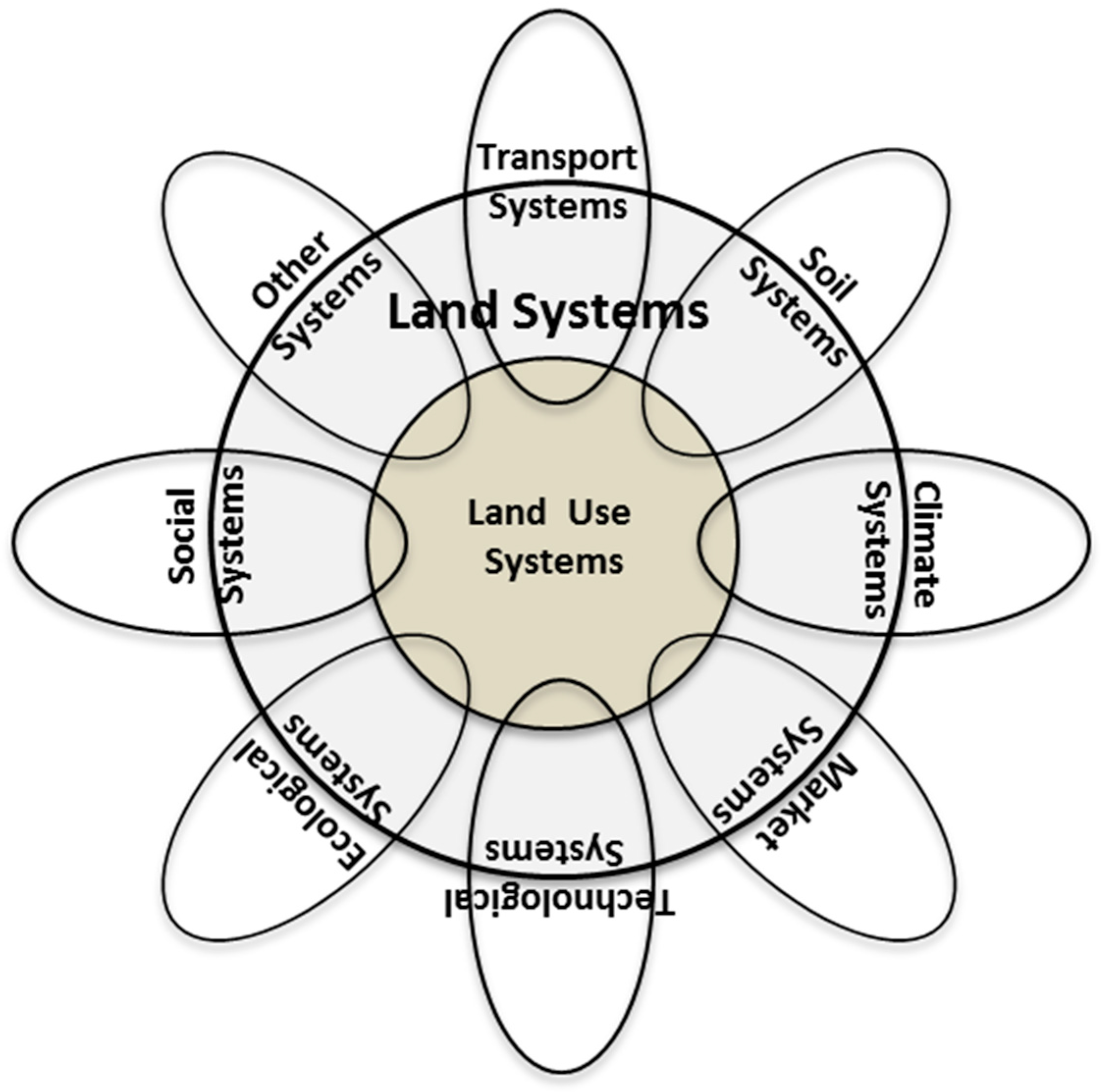
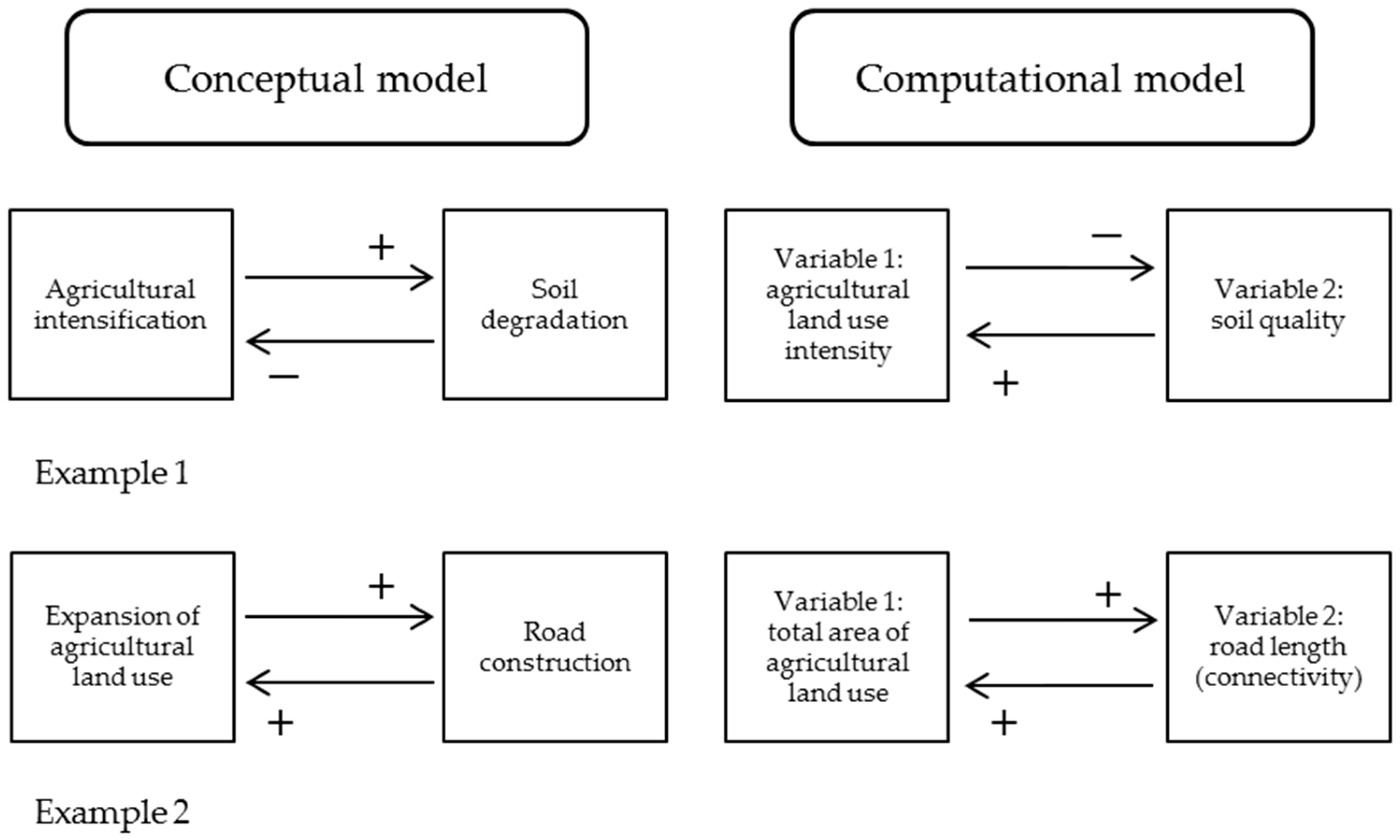
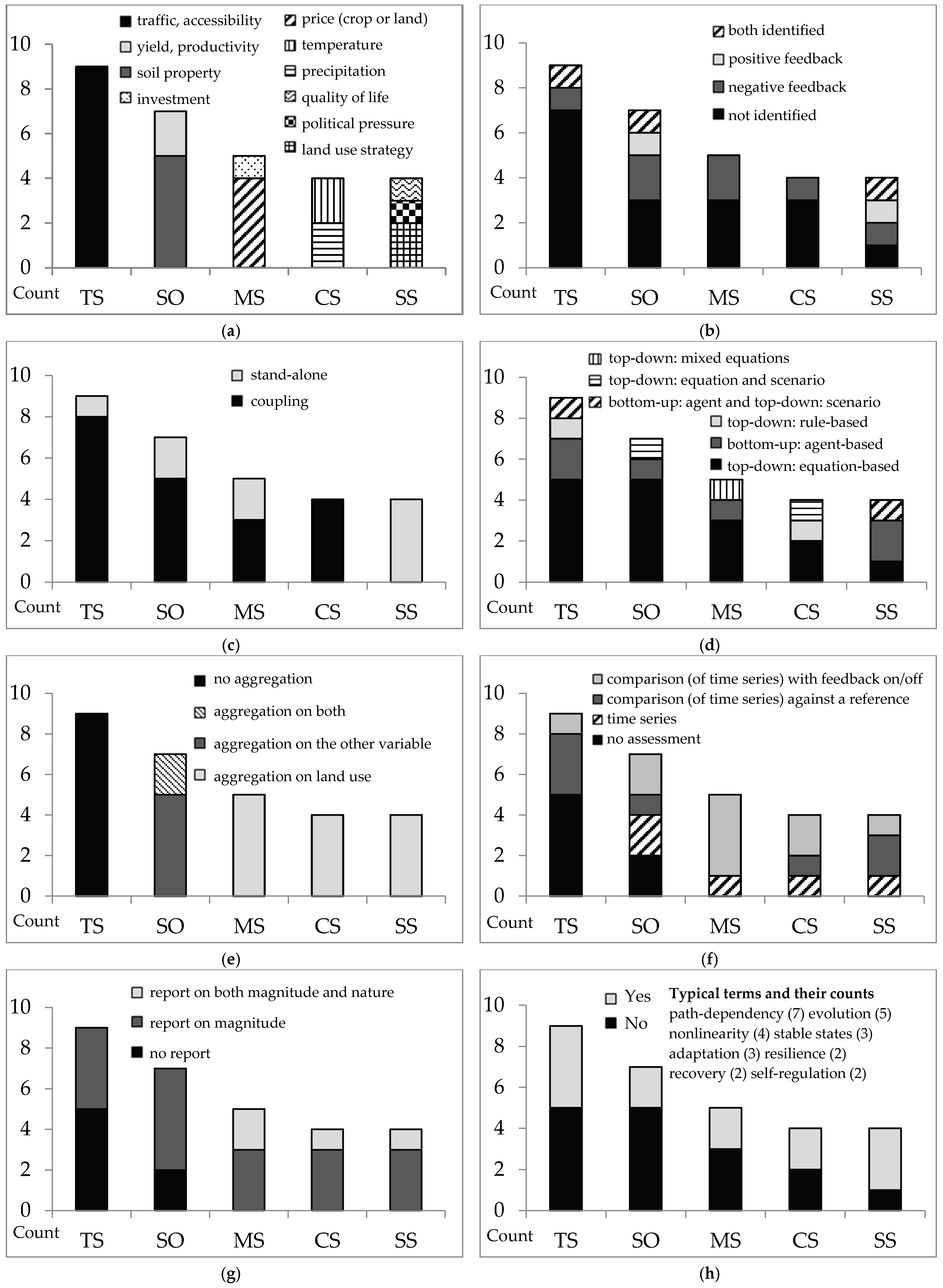
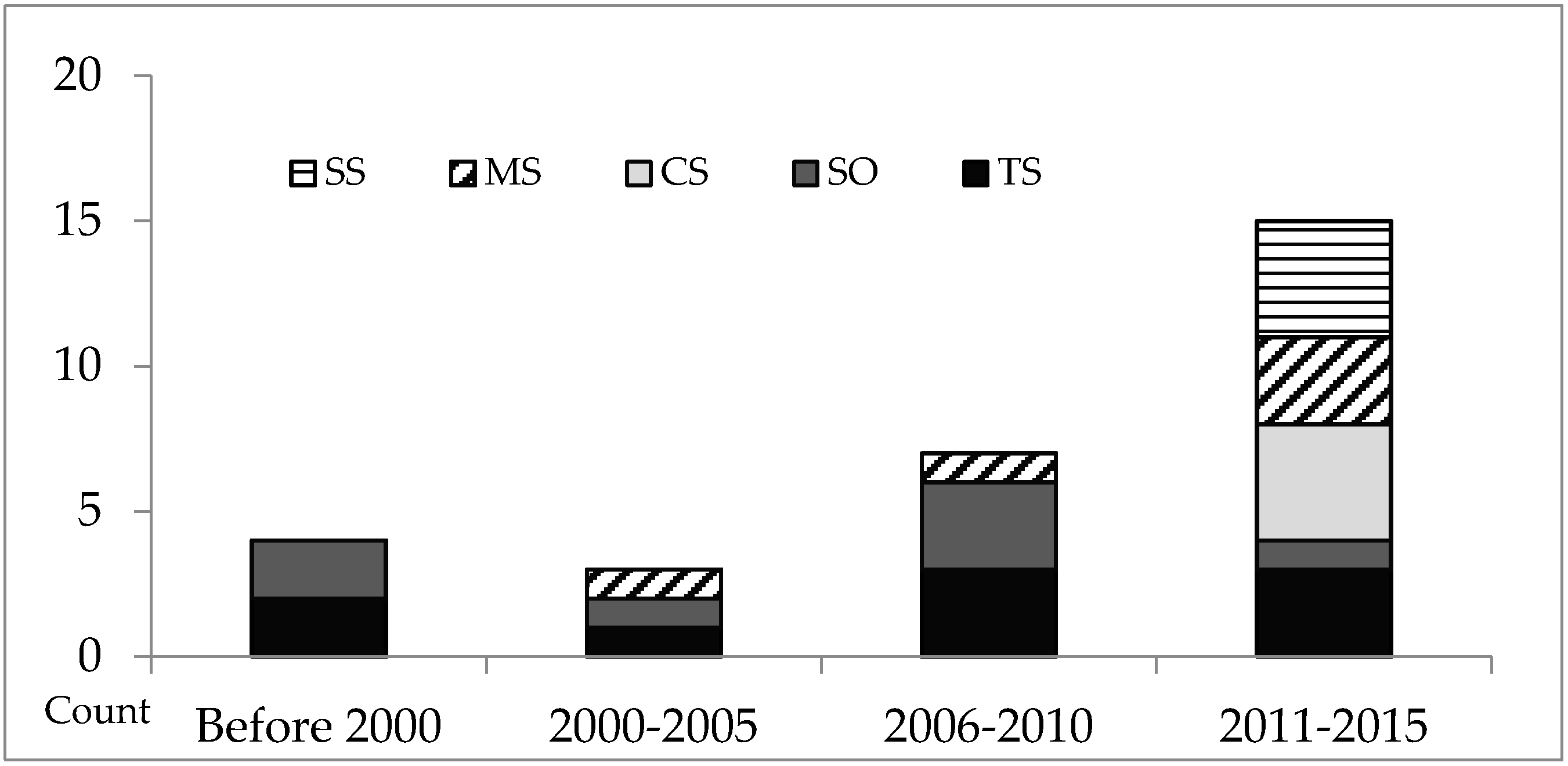
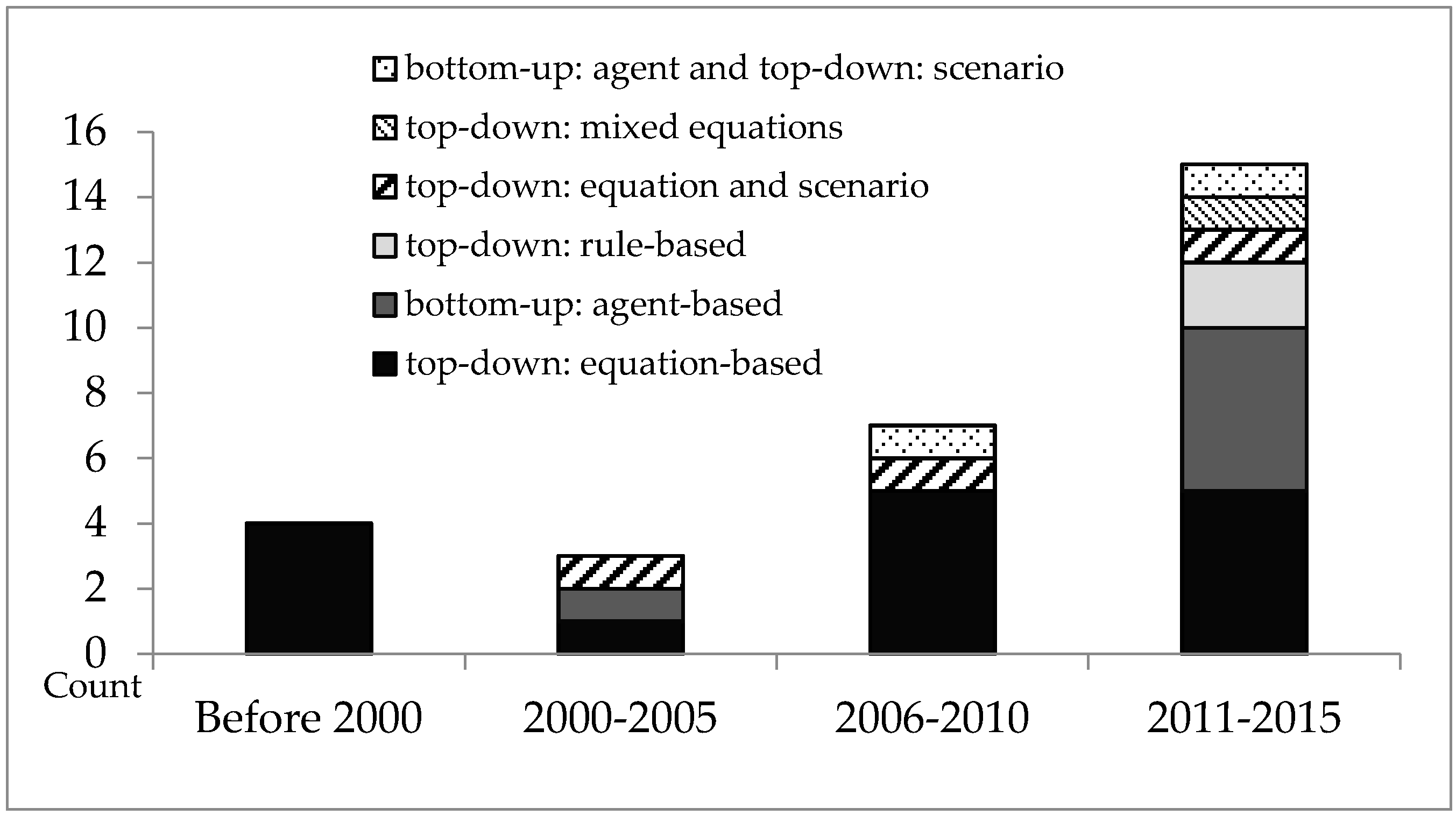
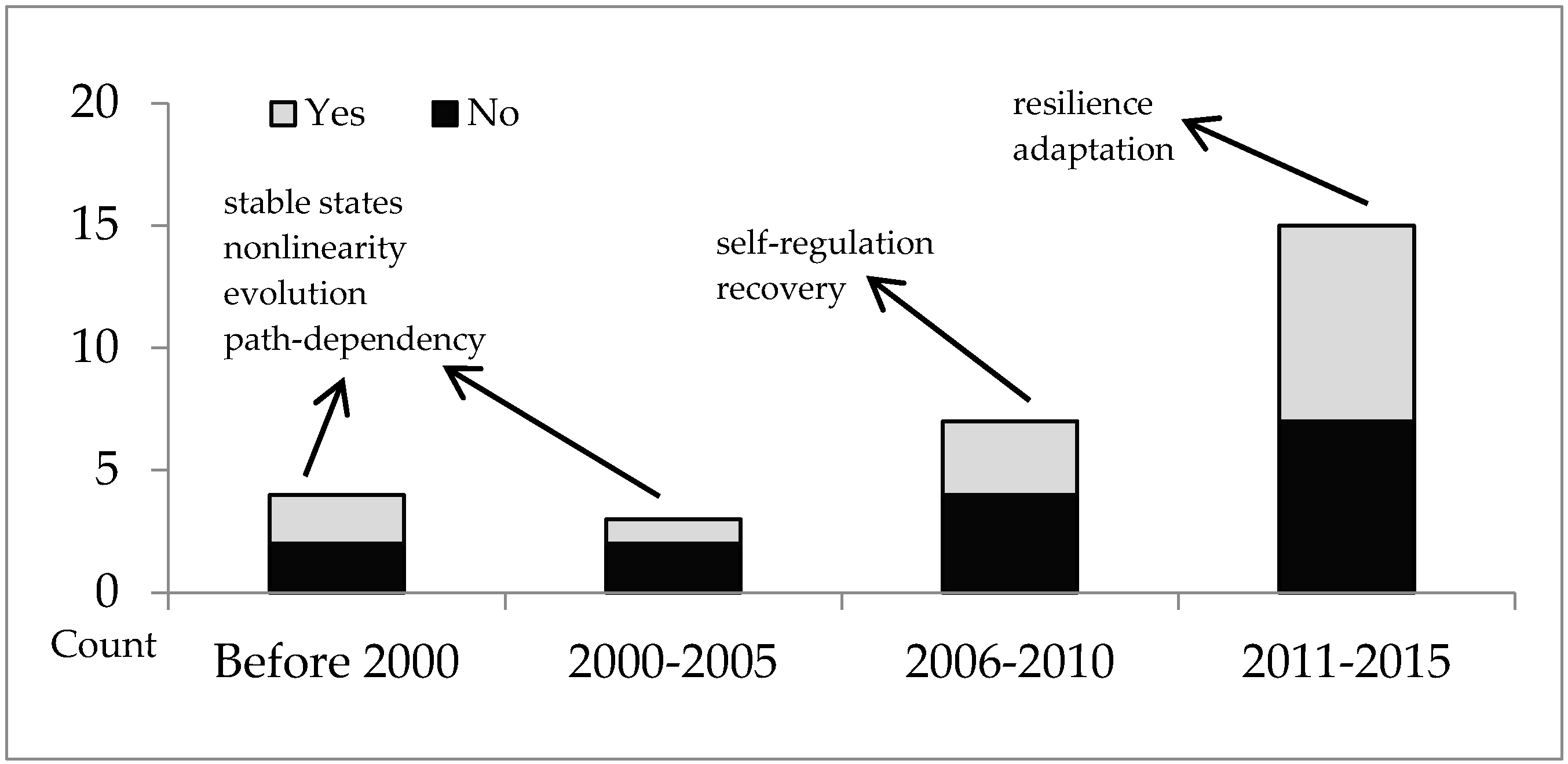
| Research Questions | Indicators | Codes |
|---|---|---|
| 1 | Variables linked | e.g., a-b-c * (with * indicating from c to a, thus a loop closure) |
| Major related system | 1. transport system (TS) 2. soil system (SO) 3. climate system (CS) 4. ecological system (ES) 5. market system (MS) 6. social system (SS) 7. technological system (TE) 8. other | |
| Feedback character | 1. positive feedback 2. negative feedback | |
| 2 | Single model vs. coupling | 1. single model 2. coupling of models |
| Modelling technique | 1. top-down: equation-based 2. bottom-up: cellular automata 3. bottom-up: agent-based 4. top-down: scenario-based 5. top-down: rule-based 6. hybrid (specify each technique) 7. other | |
| Discretisation of time | model time step on land use system (years) model time step on related system (years) frequency of data exchange (years) | |
| Discretisation of space | 1. the land use variable is aggregated to feed into the other variable 2. the other variable is aggregated to feed into the land use variable 3. both are aggregated 4. no aggregation | |
| 3 | Quantitative assessment of feedback effect | 1. no assessment 2. time series 3. comparison (of time series) against a reference 4. comparison (of time series) with feedback on/off 5. driver-state variable response relationship |
| Classification of reported land system response | 1. no report 2. report on the magnitude of the response 3. report on the nature of the response 4. report on both magnitude and nature of the response | |
| Use of terms related to complex systems | 1. regime shift 2. stable states 3. resilience 4. domains of attraction 5. nonlinearity 6. evolution 7. path-dependency 8. self-regulation 9. adaptation 10. recovery |
| Research Question | 1 | 2 | 3 | |||||||||
|---|---|---|---|---|---|---|---|---|---|---|---|---|
| Articles | Variables Linked | Major related system | Feedback character | Single model vs. coupling | Modelling technique | Model time step in the land use system | Model time step in related system | Frequency of data exchange | Discretisation of space | Quantitative assessment | Classification of reported responses | Terms related to complex systems |
| Putman, 1974 [45] | urban land development—traffic conditions—modified transport network * | 1 | 1,2 | 2 | 1 | 15 | 15 | 15 | 4 | 4 | 2 | 2 |
| Jones & O’Neill, 1992 [46] | cultivation labour, purchased inputs—soil degradation, productivity loss—conservation labour * | 2 | 2 | 1 | 1 | ND | ND | N | 3 | 1 | 1 | _ |
| Leemans, 1995 [47] | (total primary energy consumption—) global agricultural land—global deforestation—atmospheric CO2 | 3 | _ | 2 | 4,5 | 10 | _ | _ | 1 | 1 | 1 | 5 |
| Levinson, 1995 [48] | relocation of household and jobs—generated trips—traffic conditions * | 1 | 2 | 1 | 1 | 1 | 1 | 1 | 4 | 1 | 1 | 6,7 |
| Veldkamp & Fresco, 1996 [49] | percentage of five land use and cover types —erosion, soil fertility, plant disease * | 2 | 2 | 1 | 1 | 3 | 3 | 3 | 2 | 4 | 2 | _ |
| Priess et al., 2001 [27] | crop types and area—carbon and nutrients in soil—soil fertility * | 2 | 2 | 2 | 1,4 | 1 | 1 | 1 | 2 | 2 | 2 | _ |
| Rousseau & Clymer, 2002 [50] | transportation infrastructure investment—traffic pattern—composite impedance * | 1 | 1 | 2 | 1 | _ | _ | _ | 4 | 1 | 1 | _ |
| Soares-Filho et al., 2002 [51] | individual cell states and transition probability—macro-level land use pattern—distances to major land use types * | _ | _ | 1 | 2 | 1 | 1 | 1 | _ | 3 | 2 | 6 |
| Parker & Meretsky, 2004 [52] | parcel-level presence of land for urban or agriculture—macro-level land use pattern—externalities—rent * | 5 | 2 | 1 | 3 | _ | _ | N | 1 | 4 | 4 | 2,5,7 |
| Gupta et al., 2006 [53] | (construction of priced toll road—) traffic time and costs—relocation of households and jobs * | 1 | 1 | 2 | 1 | 5 | 5 | 5 | 4 | 3 | 2 | _ |
| Waddell et al., 2007 [54] | relocation of household and jobs—accessibility * | 1 | 2 | 2 | 3,4 | 1 | 3–5 | 3–5 | 4 | 3 | 2 | 7 |
| Wu et al., 2007 [55] | crop type and area—crop price* [major feedback]; crop type and area—yield * | 5 | 2 | 2 | 1 | 5 | 5 | 5 | 1 | 2 | 4 | _ |
| Koch et al., 2008 [56] | grazing area and intensity—stocking rate—landscape productivity * | 2 | 1 | 2 | 1 | 5 | 1 | 5 | 2 | 3 | 2 | 8 |
| Claessens et al., 2009 [25] | percentage of different land use and cover types and their locations—soil depth * | 2 | 2 | 2 | 1 | 1 | 1 | 1 | 2 | 2 | 2 | _ |
| Moreira et al., 2009 [57] | land use demand defined by regional level—land use supply at local level * | _ | 1 | 2 | 1,3 | 1 | 1 | 1 | _ | 1 | 2 | _ |
| Xu et al., 2009 [58] | area and location of land use for crop, forest, grass, and other—soil organic matter, and soil nitrogen content—suitability of soil * | 2 | 2 | 2 | 1,4 | 1 | 1 | 1 | 2 | 4 | 2 | 10 |
| Duthie et al., 2010 [59] | (future locations of jobs and housing—future trips—) traffic conditions—assessment of uncertainty—whether or not to improve certain part of highway * | 1 | _ | 2 | 1 | _ | _ | _ | 4 | 1 | 1 | _ |
| Strengers et al., 2010 [30] | area and location of different land cover types—land–climate interactions via surface albedo—surface temperature | 3 | _ | 2 | 1 | 1 | 1 | 1 | 1 | 1 | 1 | 5 |
| Devaraju et al., 2011 [60] | area of forest [deforestation]—temperature, precipitation, and soil carbon and productivity * | 3 | 2 | 2 | 1 | 1 | 1 | 1 | 1 | 3 | 4 | 2,3,6,10 |
| Kitchen et al., 2011 [61] | zone-level population and employment and site values—accessibility—modification on transport network * | 1 | 1 | 2 | 3 | 1 | 6–10 | 6–10 | 4 | 1 | 1 | 6,7 |
| Priess et al., 2011 [62] | policy on agricultural expansion—area of agricultural land—water available for irrigation * | 3 | 2 | 2 | 5 | 1 | 1 | 1 | 1 | 4 | 2 | _ |
| Tóth et al., 2011 [63] | land used for conservation or development—price of land *—biodiversity | 5 | 1 | 1 | 1 | _ | _ | N | 1 | 4 | 2 | _ |
| Martin & Levine, 2012 [64] | area and location of major land use and cover types—dust radiative effects—regional precipitation * | 3 | 1,2 | 2 | 1,4 | _ | _ | _ | 1 | 2 | 2 | 6 |
| Güneralp et al., 2012 [65] | local scale land availability—regional investment rate—land change at local level * | 5 | 1 | 2 | 1,1 | 2 | 2 | 2 | 1 | 4 | 2 | _ |
| Le et al., 2012 [12] | area of croplands—income—socio-economic profile—land use decision models * | 6 | 1 | 1 | 3 | 1 | 1 | N | 1 | 4 | 4 | 3,5,7,9 |
| Pendyala et al., 2012 [66] | land use [relocation of housing and jobs]—travel demand—traffic pattern * [loop 1, back to travel demand]—network conditions *[loop 2, back to land use] | 1 | 2 | 2 | 3 | _ | _ | _ | 4 | 1 | 1 | _ |
| BenDor et al., 2013 [67] | (population growth)—new residential development—park service gap—political pressure—park development * [loop 1, back to park service gap]—land attractiveness for new development * [loop 2, back to new residential development] | 6 | 1,2 | 1 | 1 | 1 | 1 | N | 1 | 2 | 2 | _ |
| Jones et al., 2013 [68] | land use and emissions—temperature | 3 | _ | 2 | 4 | 15 | 5 | 15 | 1 | 1 | 1 | _ |
| Murray-Rust et al., 2013 [69] | area and location of both urban and agricultural land—inequality in perceived residential quality of life (composed of green space, distance to shops, and noise) * | 6 | 1 | 1 | 3,4 | 1 | 1 | 1 | 1 | 3 | 2 | 5,7,8,9 |
| Oliveira et al., 2013 [28] | deforestation/agricultural expansion—precipitation—soil water—productivity | 3 | _ | 2 | 4 | _ | _ | _ | 1 | 1 | 1 | 3 |
| Robinson et al., 2013 [70] | exurban development and land management strategies—carbon storage and fluxes * | 2 | 1,2 | 2 | 3 | 1 | 1 | 1 | 3 | 1 | 1 | _ |
| Zhang et al., 2013 [71] | land use planning decision—land use change [in scenarios] | 6 | _ | 1 | 3,4 | 1 | _ | N | 1 | 1 | 1 | _ |
| Pongratz et al., 2014 [72] | LULCC fluxes—albedo, latent heat flux—CO2 concentrations and temperature * | 3 | _ | 2 | 1 | _ | _ | _ | 1 | 4 | 2 | 5 |
| Su et al., 2014 [73] | density of population and employment—travel impedances [based on distance and network]—traffic minimising goal * [if not, back to land use allocation]—accessibility and congestion measures | 1 | 2 | 2 | 5 | _ | _ | _ | 4 | 3 | 2 | _ |
| Connor et al., 2015 [74] | (global) prices of agricultural products—agricultural land use changes * | 5 | 2 | 2 | 1 | 1 | 1 | 1 | 1 | 4 | 2 | 6,9 |
| Guillem et al., 2015 [75] | farm level land use regime (crop type) —intermediate model variables (vegetation height and harvestable biomass)—skylark population | 4 | _ | 2 | 3,4 | 1 | 1 | 1 | 4 | 1 | 1 | 2,9 |
| Tsai et al., 2015 [76] | agents’ financial conditions—expected utilities from food production and other ecosystem services—land use decisions—ecosystem services for food production and other services * | 6 | 1,2 | 1 | 3 | 1 | 1 | N | 1 | 3 | 2 | 7 |
© 2016 by the authors; licensee MDPI, Basel, Switzerland. This article is an open access article distributed under the terms and conditions of the Creative Commons Attribution (CC-BY) license (http://creativecommons.org/licenses/by/4.0/).
Share and Cite
Chen, Y.; Bakker, M.M.; Ligtenberg, A.; Bregt, A.K. How Are Feedbacks Represented in Land Models? Land 2016, 5, 29. https://doi.org/10.3390/land5030029
Chen Y, Bakker MM, Ligtenberg A, Bregt AK. How Are Feedbacks Represented in Land Models? Land. 2016; 5(3):29. https://doi.org/10.3390/land5030029
Chicago/Turabian StyleChen, Yang, Martha M. Bakker, Arend Ligtenberg, and Arnold K. Bregt. 2016. "How Are Feedbacks Represented in Land Models?" Land 5, no. 3: 29. https://doi.org/10.3390/land5030029
APA StyleChen, Y., Bakker, M. M., Ligtenberg, A., & Bregt, A. K. (2016). How Are Feedbacks Represented in Land Models? Land, 5(3), 29. https://doi.org/10.3390/land5030029







